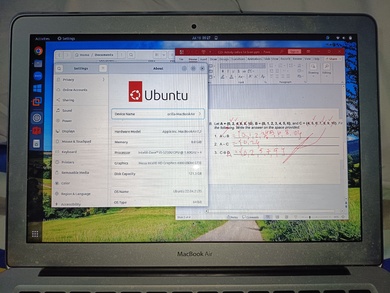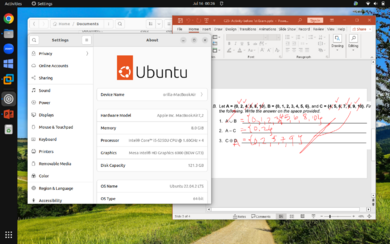Table of Contents
Switching someone to Linux
Introduction
Recently, my mother encountered a problem with her Surface Go, where the tablet's battery became bloated. While it's not overly significant yet, I suggested she stop using it immediately and offered her my spare, unused 2015 MacBook Air as an alternative. However, as I tried to reset the MacBook Air, I encountered an issue.
For some reason, the installer consistently fails, displaying an error message, and I have to keep clicking "retry." I suspect there might be an issue with the drive, but to be certain, I decided to install Linux on it.
I successfully installed Ubuntu 22.04 on the machine, and now I'm faced with a decision. One option is to continue trying to figure out where the macOS installer went wrong, or I can stick with Linux and find a suitable workflow for my mother to use.
A crucial requirement for her is the ability to use Microsoft Office. Unfortunately, I can't install Windows on this machine because it's challenging to get Windows 11 on a 2015 device. While Windows 10 is an option, I believe it might be too bloated for such an old machine, and it could struggle to perform well.
Additionally, she relies on statistical software such as Minitab, IBM SPSS, and Jamovi. Luckily, Jamovi has a Linux version available. However, Minitab is only compatible with Windows (specifically Vista and 7), so I had to set up VirtualBox on her Surface Go with a customized Windows Vista to ensure she could use Minitab securely. As for IBM SPSS, they recently dropped Linux support, and her license only allows for the latest version.

I've considered various options, including using Wine, Winapps, or a type 2 hypervisor like VMWare. Let's discuss these options further below.
Using Wine to run her software
Wine has made significant advancements in recent years, particularly concerning gaming. However, when it comes to non-gaming software, the progress is somewhat hit or miss. While most of the reports on WineHQ regarding IBM SPSS and Minitab may be outdated, the real issue lies with Microsoft Office.
The problem arises from her Office 365 Business license, as installing it can be a real pain (PITA). Even if you manage to get it to work, there's a risk that it might break in the future. So, while there's a possibility that IBM SPSS and Minitab could function with Linux via Wine, the compatibility roadblock for Microsoft Office 365 pushes me to explore other options.
Virtual Machines
Running Microsoft Office on Linux via virtual machines has been one of the most hardcore solutions that one can ever face. It is guaranteed to work but is the most expensive option because it requires decent hardware and an extra license.
In my case, the extra license is not a problem because I already have extra licenses. However, the hardware is a bit of a different story.
This is because the hardware of the MacBook Air 2015 model is not decent enough to run Windows 10 virtualized (which is why I did not bother just installing Windows 10). BUT the existence of minimized Windows 10 and 11 images has been found on the web.
Although these images, such as Tiny11 and ReviOS, are questionable to be used in an actual hardware setting because of stability concerns, they might even have bundled malware.
If they are run on a virtual machine with snapshots enabled and completely cut off internet access, the risks are lowered significantly.
So running on a virtual machine with a minimal Windows image is a viable option; the only problem is the learning curve of managing the VMs.
Seamless Integration
The last one is an idea I had when theorizing the second option. With the use of Virtual machines running minimal version of Windows, how can I make it seamless in such a way that it does the following:
- Run the VM automatically after the machine boots
- Make the software available on Ubuntu's application (without interacting with VMWare Workstation at all)
- Make the VM suspend before shutting down
Concerns 1 and 3 are doable via Systemd. For concern #1, there is a systemd template for starting virtual machines on Vmware (Github - VMware Autostart [1] ), and for concern #3, we create a root-level systemd script that interacts with vmrun (vmrun suspend /path/to/virtual_machine_file.vmx).
For concern #2, I know that VMWare has dropped seamless mode support for non-Windows guests. However, the other alternative is Winapps (Github - Winapps [2]). Using Winapps, I could allow streaming the Windows application to the Linux host and make it look seamless as seen below:

Conclusions
Only problem is, at the moment, Winapps is buggy and awkward to use. So, I ended up training my mother on how to use VMWare properly while also setting up post-shutdown scripts to suspend the Virtual machine in case she forgets about suspending it.
That being said, making someone switch to Linux requires a two-way effort. It involves you making an effort to create a workflow that works for the end-user, and it also requires the end-user to make an effort to learn the new workflow.
Having a universal workflow on a Linux desktop is unfortunately difficult due to the various options available to end-users. For example, someone setting up a workflow for you might prefer something different than my setup, which could result in different steps. While those steps might work for that specific user, they might not work as well for others who would need to invest time in learning the different workflow setup.
If we want Linux to succeed in the desktop space we need to solve that problem. Fortunately the other problems such as lack of apps and sources where to install these apps are becoming less and less of a problem because of the existence of Snap, Flatpak, Appimages and more.
That being said, that was a problem in the past and I am sure someone will invent a way to solve the workflow problem that Linux has right now.
Finally, it has been 2 weeks now as of this writing and she is happy with her current setup. That until she has enough spare money to buy another Surface device (the reason why she badly wants Surface is the Windows ink support which she uses alot) and unfortunately Pen support is limited on Linux (and in MacOS) and the spare hardware for her is not capable of supporting such feature.
PS: I have only limited screenshots to provide with the setup because I never had the time to took more and I cannot access the device now because she is using it on a day to day basis.

